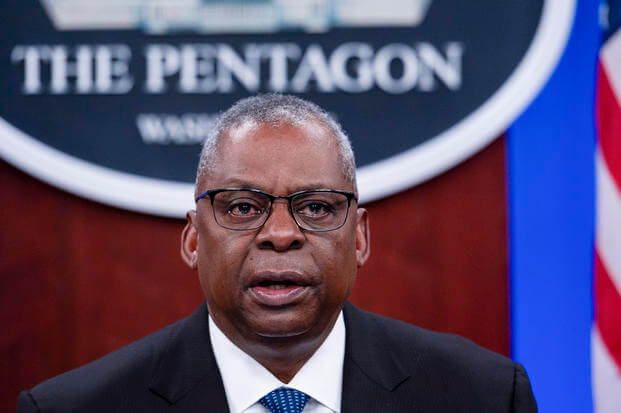WASHINGTON — Defense Secretary Lloyd Austin has ordered the USS Gerald R. Ford aircraft carrier and one other warship to remain in the Mediterranean Sea for several more weeks to maintain a two-carrier presence near Israel as its war with Hamas grinds on, U.S. officials said.
It would be the third time the Ford’s deployment has been extended, underscoring the continued concerns about volatility in the region during Israel’s war in Gaza. The U.S. has two aircraft carriers in the region, a rarity in recent years.
Multiple U.S. officials confirmed the longer deployments approved this week for the Ford and the USS Normandy cruiser on condition of anonymity because they have not yet been made public. Other ships in the Ford's strike group had already had their deployments extended.
The Pentagon ramped up its military presence in the region after Hamas' Oct. 7 attacks to deter Iran from widening the war into a regional conflict. In the months since, Iranian-backed militants in Iraq and Syria have seized on the war to conduct regular attacks with rockets, drones and missiles on U.S. military installations there.
At the same time, U.S. warships in the Red Sea have intercepted incoming missiles fired toward Israel from areas of Yemen controlled by Iranian-backed Houthi rebels. They’ve also shot down one-way attack drones headed toward the ships and responded to calls for assistance from commercial vessels that have come under persistent Houthi attacks near the narrow Bab el-Mandeb Strait.
As of Friday, there are 19 U.S. warships in the region, including seven in the eastern Mediterranean and 12 more stretched down the Red Sea, across the Arabian Sea and up into the Persian Gulf.
Austin ordered the Ford and its strike group to sail to the eastern Mediterranean on Oct. 8, a day after the attack by Hamas that set off the war.
The decision to keep the Ford — the Navy’s newest aircraft carrier — in the region comes as Israel’s defense minister, Yoav Gallant, said Thursday it will take months to destroy Hamas, predicting a drawn-out war.
U.S. national security adviser Jake Sullivan met with Israeli leaders to discuss a timetable for winding down major combat in Gaza, but they repeated their determination to press the fight until Hamas is crushed.
The Ford’s roughly 5,000 sailors have been waiting for a Pentagon decision on whether they would get to go home for the holidays. The ship left Norfolk, Virginia, in early May to deploy to U.S. European Command, and under its original schedule it would have been home by early November.
The original plan was for the USS Dwight D. Eisenhower aircraft carrier strike group to replace the Ford in the region. But Sabrina Singh, in a Pentagon briefing on Oct. 17, said Austin had decided to extend the Ford’s deployment and have both the Eisenhower and Ford covering the waters from southern Europe to the Middle East.
U.S. military commanders have long touted the effectiveness of American aircraft carriers as a deterrent, including against attacks, hijackings and other aggressive behavior by Iran and its ships, including strikes on commercial ships in the Red Sea by the Houthis.
Officials said the plan is to keep the Ford there for several more weeks.
The Eisenhower is in the Gulf of Oman and has been patrolling in the Middle East along with the USS Philippine Sea, a Navy cruiser. And three warships — the USS Carney, the USS Stethem and the USS Mason, all Navy destroyers — have been moving through the Bab el-Mandeb daily to help deter and respond to attacks from the Houthis.
Other ships that are part of the Ford’s strike group include the destroyers USS Thomas Hudner, USS Ramage, USS Carney, and USS Roosevelt.
While the U.S. regularly maintained two aircraft carriers in the Middle East during the height of the Iraq and Afghanistan wars, in recent years it has tried to turn its attention and naval presence to the Asia Pacific.











